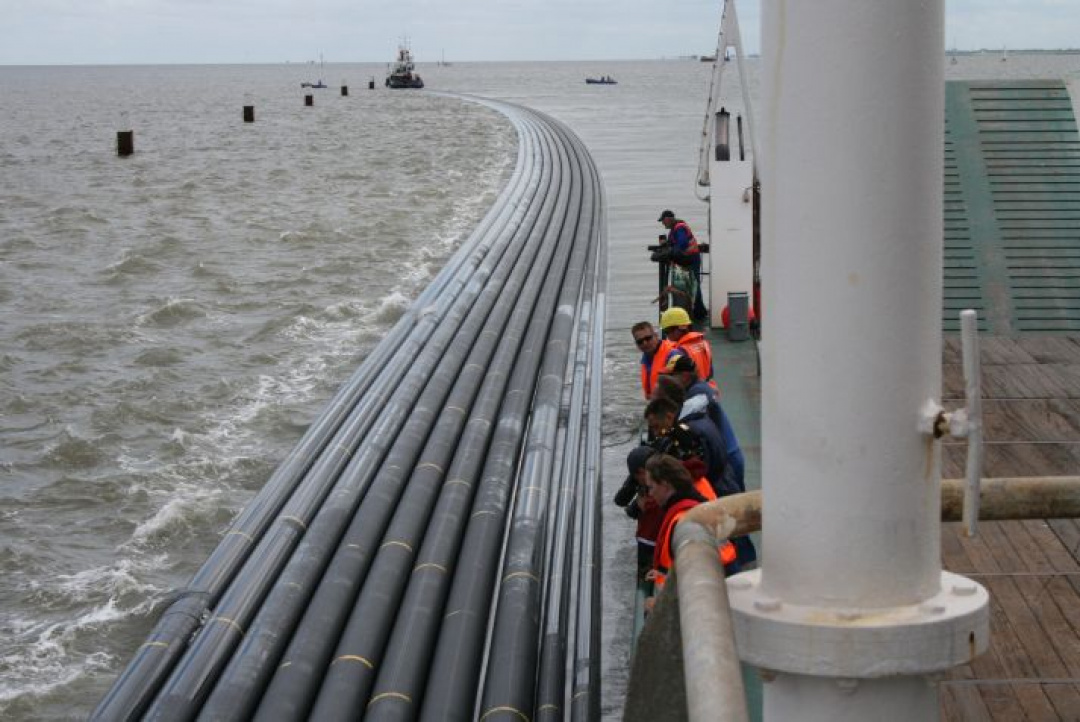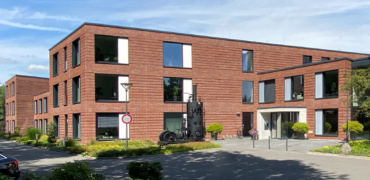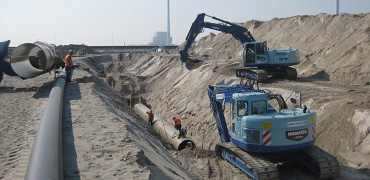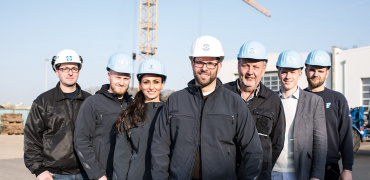Seven in one sweep
In 2007 and 2008, the Ludwig Freytag Group had set the standard for the installation of cable conduits for offshore wind parks. In the summer of 2010, the continuation started.

 15.12.2010
15.12.2010
In 2007, three offshore landfalls had to be carried out by E.ON Netz GmbH within a short space of time: On the north and south sides of Norderney (Locations OASE and Grohdepolder as well as in Hilgenriedersiel on the mainland).
This was repeated in 2008, but with a double scope of work within the same period of time. Especially for these works, a daughter company, E.ON Offshore, was established by E.ON Netz GmbH.
In 2010, almost the same performance level was required as in 2008, but under different circumstances: E.ON had since sold off their "cable business" and E.ON Netz GmbH had merged with E.ON Offshore to form Transpower GmbH. Due to tightened governmental regulations and the desire for consistency and improved growth, the "specifications document" increased from 30 pages in 2007 to two complete folders in 2010.
The length of the crossings for the offshore landfalls in Hilgenriedersiel was increased from 750 m to 1230 m to simplify the crossing of the inland side of the dyke and to position the drill site inside the main dyke and outside the bird sanctuary.

The site needed to be mobilised in four weeks and demobilised in three.While these periods may sound generous, they were actually necessary in order to satisfy the requirements of the Client and the various authorities involved in the project. As provided in the Contract, the Contractor, a consortium belonging to the LF group – LF Rohrbau, TAGU and LMR, had to fulfil the following tasks:
- Provide support in obtaining permits to undertake the work.
- The planning of all aspects relating to the execution of the works.
- The construction of the works in line with the Client specifications.
- The preparation of as-built and safety documents associated with the ongoing operation of the works.
Most significantly, seven offshore landfalls had to be completed at the earliest opportunity while complying with the strict environmental, health and safety and construction conditions that formed part of the consents.Construction on Hilgenriedersiel, where most of the drillings, and the longest ones, had to be accomplished was on the ‘critical-path’. One of the challenges was the floating of the pontoons into position at Hilgenriedersiel and Grohdepolder. This could only be done during Spring tide conditions due to the insufficient water depth that existed at other times of the year.
The drilling programme for the crossings through the intertidal areas was technically adapted to assure extreme environmental protection. For this purpose, TAGU was in charge of hydraulic engineering by establishing a ferry service to supply the intertidal working surfaces, by providing work platforms (pontoons) in these intertidal zones and positioning heavy caterpillar cranes and floating cofferdams.LMR completed all the HDD works, while LF Rohrbau carried out all earth and pipeworks.
The works started on 22nd June 2010 by mobilisation to Port Norddeich and the island of Norderney. A part of the port area was rented especially for this project with a storage yard for loading all necessary goods for the intertidal work sites arranged by TAGU.During site mobilisation, all pontoons and equipment were delivered to this yard and prepared for usage. The pontoons were inspected by German Lloyd and a “Fit for Purpose Certificate” issued for each pontoon. After this, the set-up of the intertidal work sites began with installation of the support-pontoons and ferry service. This was followed by floating and positioning the pontoons and the floating cofferdams.
While setting up the pipework construction sites, it became increasingly clear that the welding area for the HDPE pipes along the water front of Norderney would, unfortunately, be unavailable. A solution had to be found, as the pipes could not be connected to one string of up to 560 m without these areas. After several alternatives were discussed, a solution was finally agreed with full length pipeline segments extruded directly into a fjord at the manufacturing plant in Norway and these being towed across the North Sea to the work sites. Following this proposed solution, a row of piles were installed following consultation with the National Park Administration in order to “park” the pipeline segments on the mudflats. At 05:00 hrs on 24th July 2010, the pipelines arrived spectacularly at Tonne D2, to the north of Norderney and, were handed over and then dragged through the channel past the eastern waterfront with a convoy, under the supervision of TAGU.
This procedure was very difficult and complex, as the following aspects were to be considered:
- Ten pipelines with lengths of 460 m to 630 m had to be pulled in a bundle through the channel between Norderney and Juist.
- The channel has a very narrow shipping route.
- The currents in the channel were strong and changed depending on the tides and the weather.
- Conditions of the water and marine police, resulting from the 3 above points, had to be adhered to.
With considerable safety regulations (even aerial surveillance), the pipes could then be floated successfully without one single lost string. A special compliment is due to TAGU for the execution of this procedure.
With the completion of the site preparation, the set-up of the HDD construction sites began.These works started in Hilgenriedersiel on 19th July 2010, with drilling works commencing one week later. On the island of Norderney, the set-up began on Grohdepolder in the first week of August and at OASE a week later.Works were scheduled to run 24 hours a day in order to finish the drilling works as quickly as possible to reduce the duration of works in the extremely ecologically sensitive areas. The Client, however, could only agree to this plan under special circumstances, initially causing a large part of programmed buffer time to be lost. However, due to the outstanding performance of the drilling team, it was possible to regain this time.
With the beginning of the pilot drilling works it turned out that permission to access some areas of the mudflats beneath which the drills extended had not been clarified.After this problem was resolved by technical ingenuity, it was necessary to overcome geological risks that occurred in the form of peat beds close to the drill exit points.Due to these, the flow of drill fluid back to the drill site ceased during the last 100 m of the drilling.As soon as the pilot broke surface and the pressure of the drill fluid dropped, these peat beds released this build-up of bentonite at the exit point.The prudent concept of the LF Group that came up with the floating cofferdams, was a complete success.The Invitation to Tender required a boundary for the building pits in the mudflats in order to avoid uncontrollable mud loss into this sensitive environment. In this regard, TAGU had developed SBUs in 2008.These have extremely low draft and can thus float in and be deployed anywhere in the intertidal zone.The ballast tanks can be used as a collection tank for mud, if required, which was successfully used during the first drilling.
Another challenge was to connect the pipeline segments while pulling in.Drilling lengths were each 1230 m.Due to the location and production capacity of the Norwegian plant, the strings were prefabricated in individual lengths of up to 625 m.Therefore, the pull-in had to be interrupted for welding.This procedure is simple on land, but it is a challenge when these works have to be carried out at all states of tide on the intertidal mudflats under strict conditions. A special pipe guiding and fixing construction had to be built on the deck of the pontoons especially for this purpose, allowing the welding crew of LF Rohrbau (special thanks goes to the crew at this point) to connect the pipes without any problems.
A further challenge was to move the floating cofferdams.Even though the above mentioned vessels had a very low draft, they were confronted with the very low water depths at high tide in combination with the terrain roughness.With the coordinated action of the mud control crew (another requirement of the Client), under the leadership of TAGU, in compliance with LMR’s time schedule, each movement of the cofferdams was completed successfully.
On the OASE construction site there were actually no surprises, except for a welded joint that failed and the frame plate on the rig which was fixed to the abutment that broke.With the cooperation of a local shipyard, an appropriate steel plate was organized immediately and was installed overnight, and drilling works could continue the next morning.A drill pipe failure that occurred during reaming of the borehole was unfortunate.Even though freshly inspected drill pipes were used, one drill pipe broke at the joint. Thanks to the well experienced drill crew, both pieces were recovered so that the drilling works could successfully continue and the deadline held.
The Ludwig Freytag Group, with its companies TAGU, LF Rohrbau and LMR, tackled the completion of an utmost complex task under extreme conditions within a very short period of time. This task was accomplished to the Client’s complete satisfaction. These works were successfully completed due to a team that works together very well and is experienced in dealing with certain situations under special conditions. With this construction site, the Ludwig Freytag Group, and its subsidiaries, have proved that they are major players in the near-shore and landfalls business and have taken a leadership position.
all news

